Table of contents —
Introduction —
How a dynamic approach to sharing customer insights is helping Orange fulfill its brand promise of 'human first'.
The Orange story is one to inspire any insights professional. Find out how they left behind their traditional approach to market research and in its place built a dynamic, interactive and customizable analysis and reporting system.
Consumers today have high expectations of every business they interact with. They’ve been taught to expect a targeted and personalized experience with every encounter. They want to be recognized as individuals with their own needs and wants.
To remain competitive in the face of these expectations, businesses must be armed with data lots and lots of data—about their customers. And they must be able to use this data to anticipate customer needs and provide a unique experience at every interaction. This is especially true in a hyper-competitive market like telecommunications–and this is exactly the challenge faced by our client Orange, one of the world’s leading telecommunications providers.
As part of Essentials2020, the five-year strategic plan it launched in 2015, Orange committed to reinventing customer relationships, to meet their essential needs and offer an unmatched customer service experience. This was a bold commitment and Orange knew that to achieve it they would have to engage their customers in constant conversation, to truly listen and act on their feedback.
To support the business to achieve this ambitious goal, Russell King, Director of Group Brand & Customer Experience Research at Orange, knew that his Market Research team would have to fundamentally transform how they delivered insights to the business.
We were extremely fortunate to collaborate with Russell and his team to help deliver on their vision for the future of data insights at Orange. We’re excited to share this inspirational story of how they left behind their traditional approach to research and in its place built a dynamic, interactive and customizable analysis and reporting system that was designed from the ground up to meet the needs of their stakeholders.
.png?width=600&name=Untitled%20design%20(14).png)
“The changes we've made have significantly increased the value we're delivering to the business. We're contributing at a strategic level and playing a key role in important business decisions. It's what every research team is ultimately trying to do, isn't it?”
— Russell King
Director of Group Brand & Customer Experience Research, Orange
The essential challenge —
Orange's Market Research team is a key player
To deliver on the commitment of Essentials2020 and to reinvent the customer relationship, the Market Research team knew they would have to support the business to truly listen to their customers and empower them with insights that would enable them to act on customer feedback.
It was a challenge that required the team to take a completely new approach to how they delivered customer insights to the business. “We had to change the way we operated,” says Russell, an insights expert with over 25 years in the industry. “To achieve the vision set out in Essentials2020, we needed to be able to deliver insights in a way that would compel our decision-makers to engage with and actively use data to drive strategy and deliver growth.”
Traditional approach too monochromatic
Like many other corporates, Orange’s previous approach to brand research was primarily centrally driven and top down, with data gathering and analysis managed through corporate headquarters with the support of a full-service agency.
The agency would analyze the data and produce reports, then Russell’s team would decide what level of information was appropriate for each country and send them only that data. If an in-market team wanted greater depth, they were sent Excel tables with extra data.
“Given the static nature of the information we were giving them, it’s hardly surprising that the local teams weren’t heavily engaged with the research. They simply didn’t see it as particularly useful or relevant.”
This traditional approach was not ideal for several reasons. For one thing, a lot of Russell’s budget was invested in production of data. “With so much being spent on relatively low-value tasks, there was little left over to invest in strategic analysis that would deliver obvious and tangible value to the business,” says Russell. This was an imbalance he was determined to address.
Another challenge was that the Market Research team was often working with information that was out of date because it took so long to process the data, curate it and make it available. The team was mostly learning in review and changes were often made after the fact, rather than proactively driving the business forward.
The biggest challenge Russell and his team faced was that they generally provided research findings to their stakeholders in the form of static PowerPoint decks or massive spreadsheets with a bewildering array of data. Stakeholders couldn’t easily interact with and explore the data, limiting their ability to use the information to build their understanding of the dynamics of their local market. Without this understanding, it was almost impossible to develop and execute timely, informed and datadriven brand and marketing strategies.
“Given the static nature of the information we were giving them, it’s hardly surprising that the local teams weren’t heavily engaged with the research. They simply didn’t see it as
particularly useful or relevant,” says Russell. “We really wanted to be able to give them access to the specific insights they needed,to encourage ongoing conversation about our customers. But our existing approach was too basic.”
It was time to add some color.
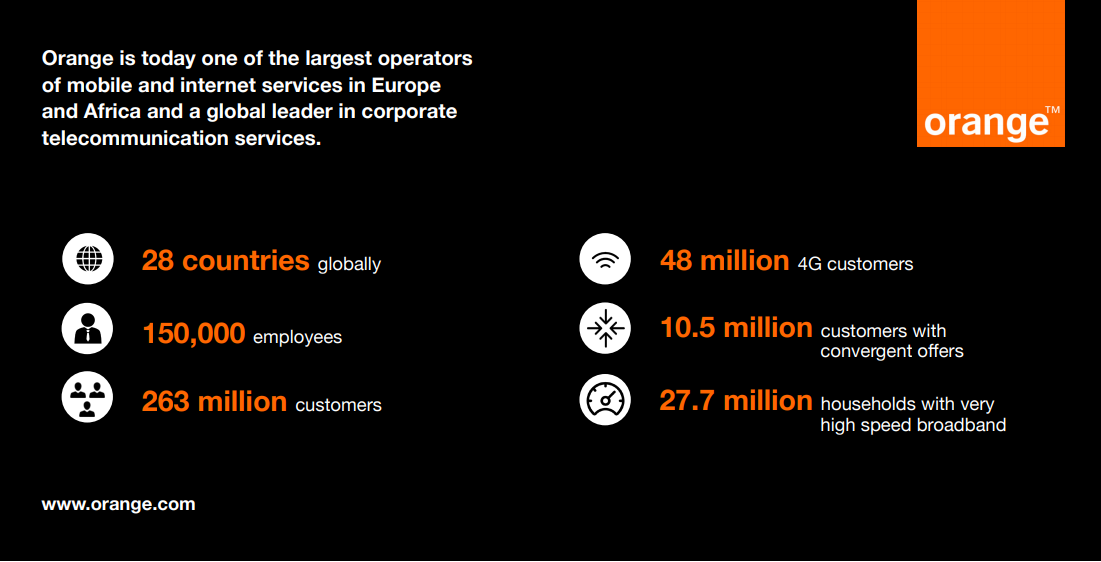
Classic challenges —To help Orange focus on their customers, the Market Research team had to overcome some barriers:
|
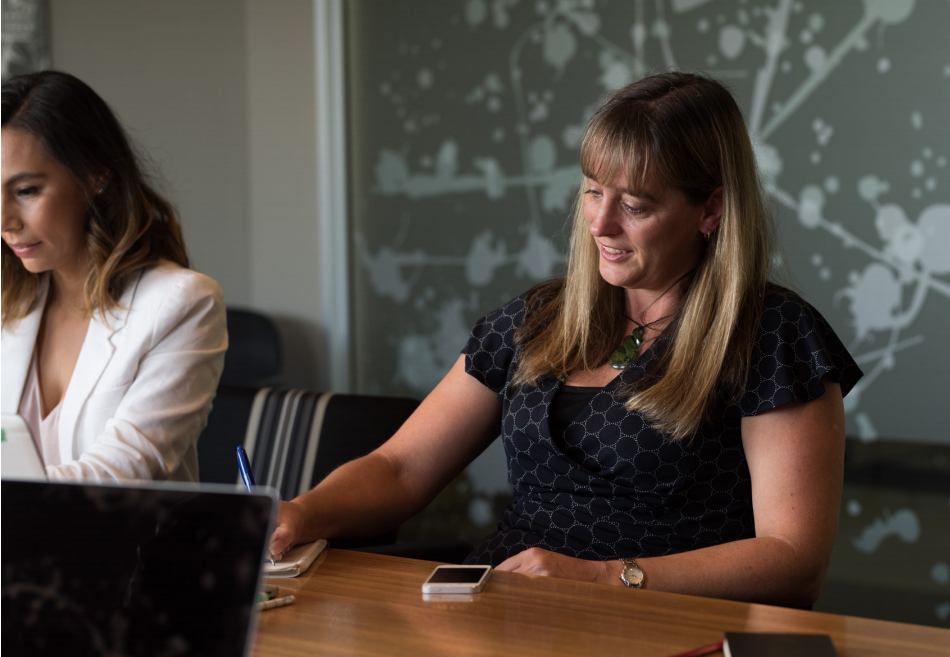
A colorful solution —
"We were seeking simplicity, intuitiveness, and clearly displayed insights. We wanted to combine a great digital solution with a robust understanding of the importance of accurate data. If data accuracy can't be guaranteed, it doesn't matter how good the end solution looks."
With their goals set, the Market Research team set out to re-invent and re-focus the market research function. It was obvious that a digital approach would be central to solving their challenges and the team decided to partner with a range of technology suppliers to achieve their goals. They chose to work with Infotools to create an online, interactive reporting platform for global brand tracking and customer experience studies.
“From the start, we knew that technology would be at the center of the process,” says Russell. “Good technology increases the efficiency of our processes and reduces production costs. Most importantly, though, we knew that a digital solution would be key to helping us engage with the 30 local markets covered by our brand research program.”
“We were seeking simplicity, intuitiveness, and clearly displayed insights. We wanted to combine a great digital solution with a robust understanding of the importance of accurate data. If data accuracy can’t be guaranteed, it doesn’t matter how good the end solution looks,” continues Russell.
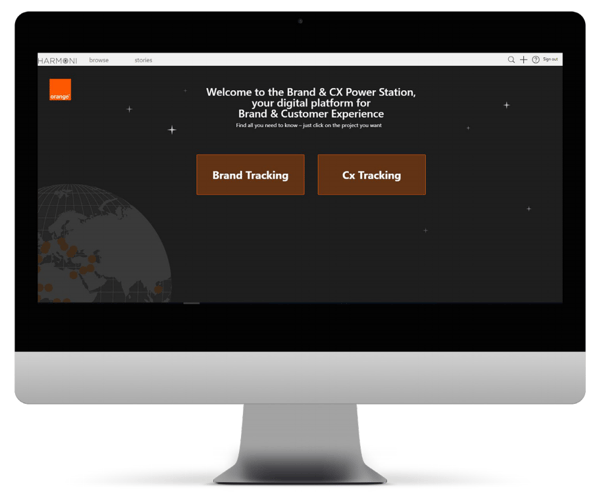
"We wanted to ensure that what the digital platform delivered would be compelling and relevant to all of the teams using it... We also specified that even someone with a low level of technical ability should be able to jump on the platform and quickly see the data or insights they needed. It wasn't going to work if they couldn't drive it themselves and had to keep coming back to my team for support."
Power to the people
The overarching objective was to design and develop a platform that would meet the needs of the widest possible range of users. The Orange team needed a solution that would:
-
Solve regional, logistical and communication issues.
-
House Orange’s data in one place.
-
Deliver research results more quickly, but retain scope for deeper, more strategic analysis—all within existing budgets.
-
Readily produce localized reports and analysis, including pre-set, tailored reports and visualizations that would help local teams identify initial patterns or trends.
-
Ensure the right balance of data integrity and user experience—that is, an easy, intuitive and engaging user interface that delivers insights and visualizations built on data that is trusted completely.
-
Encourage active engagement with the research data by enabling stakeholders to explore the data set themselves, down to respondent level.
-
Create up to date reports and dashboards that can be easily shared to encourage timely conversations across the wider organization, contributing to better decision-making and action-taking.
-
Empower their research agency to contribute at a more strategic level and have a greater impact on decision-making by reducing the amount of time they spent managing manual production-related tasks.
-
Save their report settings, which are automatically updated the next time new data is loaded. This means they only ever have to set up their requirements once.
“An important driving principle behind the platform design was to ensure the solution reflected the core needs of our teams,” says Russell. “We wanted to ensure that what the digital platform delivered would be compelling and relevant to all of the teams using it. To achieve this, we ran a series of design workshops to ensure we had a clear understanding of the requirements of all the key stakeholders, including the local teams.”
“We also specified that even someone with a low level of technical ability should be able to jump on the platform and quickly see the data or insights they needed. It wasn’t going to work if they couldn’t drive it themselves and had to keep coming back to my team for support,” continues Russell.
The resulting platform, built in Infotools Harmoni and aptly named the Power Station, provides interactive and interlinked visualizations that have been built to allow just the right balance between flexibility and tailoring, without being too complex to make sense or be useful to non-technical users. This balance allows users to find exactly what they need and easily share it with their stakeholders—all without having to ask the Market Research team for help!
“The Power Station brings together the results of two different research programs, carried out by two different suppliers, and lets our stakeholders explore all the data in one place,” says Russell. Together, the two parts of the platform, Brand Power Station and Customer Experience Station, put key B2C tracking data into the hands of every Orange market, regional and global group.
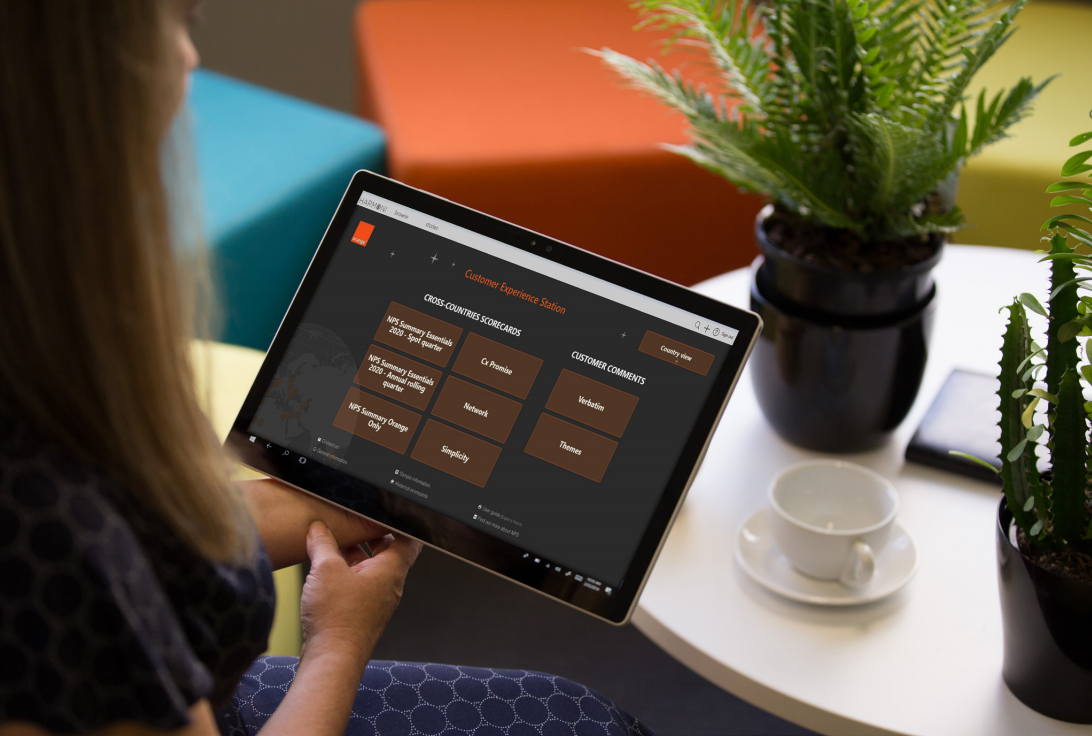
What does the Power Station do —
Not just an online reporting tool or dashboard creator, the Power Station empowers users to investigate research data and identify and visualize patterns and trends themselves without always having to rely on experts.
Within a single digital platform, users not only access pre-built reports, but also dig deeper into the data sets and create their own reports and dashboards, adding commentary to form their own stories. They can then share these stories instantly via direct platform links, or export to Orange PowerPoint templates. Any content created and shared in the Power Station is instantly updated as soon as a new data wave is loaded. Users set up their requirements once, and the rest is taken care of.
“Orange stakeholders now have simple and intuitive access to current research as well as all the updates, allowing them to easily build and share stories. It has promoted better conversations across the company and enabled decision-making that is truly customer-oriented. At the same time, our data analysts can still explore, in detail, answers to any question they are asked,” says Russell.
The fruits of labor —
"Our ongoing transformation has been built on digital solutions like the Power Station. It's let us move from manual, siloed processes, to a system that enables relevant information to be easily accessed across the business."
Essentials2020 put customers firmly at the heart of Orange, making customer data and insights a strategic imperative.
“We’ve pivoted to support this strategy. And the solution we developed with Infotools was an essential part of making that move,” says Russell. “Our ongoing transformation has been built on digital solutions like the Power Station. It’s let us move from manual, siloed processes, to a system that enables relevant information to be easily accessed across the business.”
Reaping the benefits of change
Liberation through self-service
The Power Station enables users to investigate data for themselves, without having to rely on (and wait for) experts to do it for them. This has promoted better conversations across the company and led to more collaborative decisions about future strategies and approaches.
The initial goal was for the Power Station to answer at least 70% of the questions that an in-country team might typically have. This would enable them to ‘self-serve’ to get insights as soon as they needed them. Russell is happy to report that this goal has been well and truly met.
“Not only do we get fewer ad hoc requests now, it’s freed us up to work on the more sophisticated and complex questions where our expertise is really needed.”
“Of course, the Market Research team still receives some relatively simple questions,” continues Russell. “But now, with the Power Station at our fingertips, we can answer them in minutes – about as long as it used to take to write an email to the agency asking them to answer the question! This not only saves time, it also saves money because we can provide answers ourselves, rather than having to involve the agency.”
One of the key features of the Power Station is that it allows the Market Research team to make data available to the local teams much more quickly—in days rather than weeks—and this allows the local teams to see patterns earlier and act on insights much faster.
More budget to invest in higher value input from the agency
The Power Station has significantly reduced the amount of money spent on manual work the research agency used to perform. “Reducing the pressure on production has increased focus on strategic thinking,” says Russell. “We’ve been able to shift our investment to accessing the knowledge and experience of senior directors in the research agency.”
These senior experts bring a wider view, have more influence and can contribute at a more strategic level, something that adds much greater value for a global brand like Orange.
Quicker, smarter decision-making
One of the key features of the Power Station is that it allows the Market Research team to make data available to the local teams much more quickly— in days rather than weeks—and this allows the local teams to see patterns earlier and act on insights much faster.
A great example of this is the role the Power Station played in helping Orange to quickly understand the brand challenges they faced in Spain following an acquisition and put strategies in place to manage these challenges.
The Market Research team was included in the strategy discussions from the beginning. Using insights available through the Power Station, they helped the strategy team explore and immediately answer a range of questions about the local market. The information they provided was crucial and directly contributed to new ideas, influencing the strategy that was eventually implemented.
“We played a key role in helping Orange quickly understand the brand challenges we faced in Spain,” says Russell. “The Power Station let us provide insights and answer questions in real time. We were able to influence strategy, rather than just providing data to answer questions in retrospect.”
Full value from verbatim data
Previously, open-ended questions were expensive to administer. The complexity of managing multiple languages, together with the high cost of pre-coding translation, meant they weren’t widely used. Often they’d just show up as a small number of quotes in a static report.
“The availability of the Power Station has dramatically changed this,” says Russell. “Open-ended questions are now high-value and have a greater and much more direct impact on business decisions.”

Orange now uses automatic translations from local verbatim language to English, then uses text analytics to analyze the verbatims, looking for themes and generating sentiment scores. While text analytics isn’t new technology, what’s unique about Orange’s approach is that they’ve integrated text analytics directly into the Customer Experience Station.
Users can interrogate and assess the interplay between themes, verbatims and other survey variables—including NPS groups—all at the respondent level (while still maintaining personal anonymity). They can even dive into the actual text to better understand the context. Additionally, because English is not the preferred language of all the local teams, all verbatims are also available in local language to ensure nuanced meaning is not lost.
The automation of text analytics has made open-ended questions a viable and valuable option for Orange’s big international studies, tripling the use of openended questions for the same budget. Use of open-enders is now viewed as an investment in deeper, more reliable insights, as opposed to simply being seen as an added cost.
“We’ve been able to respond with much more agility, while still maintaining high quality. It’s improved our ability to deliver insights that influence business decision-making, and it’s definitely raised our profile within the company.”
Strengthened internal brand for the Market Research team
Despite the centralized approach and global responsibility of the Market Research team, brand and customer experience data was not always widely used across the company. The introduction of the Power Station is working to change that by making sure customer insights are available in a timely, accessible, relevant and dynamic way.
This encourages active engagement with the data throughout the organization, beyond the traditional stakeholders of marketing and brand, and has helped create a culture where the customer is at the heart of Orange’s most important decisions. There’s recognition across the business that the Market Research team is contributing to this change in how consumer insights are viewed and used at Orange.
“We’ve been able to respond with much more agility, while still maintaining high quality. It’s improved our ability to deliver insights that influence business decision-making, and it’s definitely raised our profile within the company,” concludes Russell.
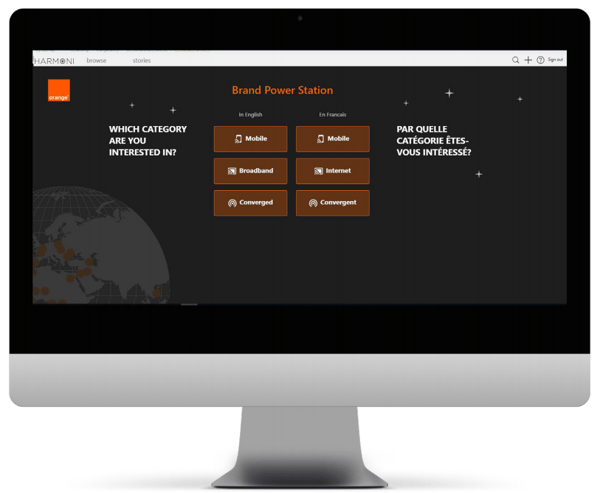
An Insights Revolution —
From a monochromatic past
To a colorful present
Static, highly structured data was of limited use to local markets
>
Self-serve, interactive reporting and customized analysis now meet the specific needs of local teams
Insights data was not widely distributed or shared so wasn’t used as an essential tool in decision-making
>
Research data is now quick and easy to share, keeping it front and center when developing strategy
Open-ended questions were impractical due to cost, limiting their value to the business
>
Open-ended questions are now high-value and have more direct impact on business decisions
Market Research team had a reduced profile and limited influence at a strategic level
>
Market Research team now included in key discussions and able to influence brand and customer experience strategy
A lot of research budget allocated to relatively low-value production-focused tasks
>
Budget now more focused on strategic analysis and input, delivering far greater value to the business
Conclusion —
The Power Station has helped Russell's team achieve its goal of making consumer insights available in a timely, accessible, relevant and dynamic way. Decision makers now actively engage digitally with the data and this has played a pivotal role in Orange achieving its 'human first' vision, where the customer is truly at the heart of the company's most important decisions.
In a world of ever-increasing consumer expectations, Orange is giving itself a competitive advantage by delivering a consistently high-value, high-quality and highly personalized experience to all customers at every interaction. They call this their ‘human first’ approach and it’s the key driving force behind their most important business decisions.
Access to rich consumer insights is critical to this ‘human first’ approach—and this is where Russell and his Market Research team have excelled. Working with Infotools, Russell and his team created the Power Station to fundamentally transform how customer insights are delivered to decision-makers at Orange.
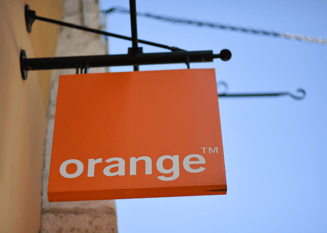
The Power Station pulls in data and dynamically displays up-to-date, customized, user-friendly insights directly to stakeholders. Gone are the days of ‘looking in the rearview mirror’, working with months-old data presented in static and uninspiring slide decks and spreadsheets. Instead, stakeholders can now get immediate answers to questions, enabling them to make strategic business decisions on the go. This has significantly increased the value of this information across the whole of Orange’s business.
At the same time, the Market Research team has reduced their spend on relatively low-value, production-focused work. Instead, they’re now investing this budget in strategic input from senior, experienced researchers, delivering yet more value to The Orange Group.
The Power Station has helped Russell’s team achieve its goal of making consumer insights available in a timely, accessible, relevant and dynamic way. Decision makers now actively engage digitally with the data and this has played a pivotal role in Orange achieving its ‘human first’ vision, where the customer is truly at the heart of the company’s most important decisions.
About Infotools —
Infotools is an award-winning market research software and services provider, used globally by some of the industry’s most curious minds. We help insights professionals explore their data, answer more questions and provide greater insights. Our integrated, cloud-based software platform, Infotools Harmoni, is purpose-built to simplify the processing, analyzing, visualizing and sharing of market research data.
Ready to put consumer insights at the heart of your organization?
Let us show you how the right technology can help you dig deeper, find relationships and patterns, and add real value. Drop us a line and let’s have a chat about the future of data insights in your organization.

